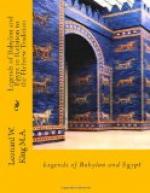(2) Even so, before starting on the work, he took the further precautions of ascertaining that the omens were favourable and of purifying his city from all malign influence.
We may conclude, then, that in the new Sumerian Version of the Deluge we have traced a logical connexion between the direct warning to Ziusudu in the Fourth Column of the text and the reference to a dream in the broken lines at the close of the Third Column. As in the Gilgamesh Epic and in Berossus, here too the god’s warning is conveyed in a dream; and the accompanying reference to conjuring by the Name of Heaven and Earth probably represents the means by which Ziusudu was enabled to verify its apparent meaning. The assurance which Gudea obtained through the priest of Nina and the sign, the priest-king Ziusudu secured by his own act, in virtue of his piety and practice of divination. And his employment of the particular class of incantation referred to, that which conjures by the Name of Heaven and Earth, is singularly appropriate to the context. For by its use he was enabled to test the meaning of Enki’s words, which related to the intentions of Anu and Enlil, the gods respectively of Heaven and of Earth. The symbolical setting of Gudea’s vision also finds a parallel in the reed-house and wall of the Deluge story, though in the latter case we have not the benefit of interpretation by a goddess. In the Sumerian Version the wall is merely part of the vision and does not receive a direct address from the god. That appears as a later development in the Semitic Version, and it may perhaps have suggested the excuse, put in that version into the mouth of Ea, that he had not directly revealed the decision of the gods.(1)
(1) In that case the parallel suggested by Sir James Frazer between the reed-house and wall of the Gilgamesh Epic, now regarded as a medium of communication, and the whispering reeds of the Midas story would still hold good.
The omission of any reference to a dream before the warning in the Gilgamesh Epic may be accounted for on the assumption that readers of the poem would naturally suppose that the usual method of divine warning was implied; and the text does indicate that the warning took place at night, for Gilgamesh proceeds to carry out the divine instructions at the break of day. The direct warning of the Hebrew Versions, on the other hand, does not carry this implication, since according to Hebrew ideas direct speech, as well as vision, was included among the methods by which the divine will could be conveyed to man.




